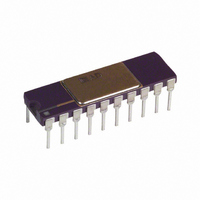AD693AD Analog Devices Inc, AD693AD Datasheet

AD693AD
Specifications of AD693AD
Available stocks
Related parts for AD693AD
AD693AD Summary of contents
Page 1
FEATURES Instrumentation Amplifier Front End Loop-Powered Operation Precalibrated Input Spans Independently Adjustable Output Span and Zero Precalibrated Output Spans: 4–20 mA Unipolar 0–20 mA Unipolar 12 Precalibrated 100 RTD Interface 6.2 V Reference with ...
Page 2
... Input Span 60 mV Input Span Into Pin 6 Output Span = 4– REF Loop Powered, (Figure 10) 3-Wire Mode, (Figure 15) –2– AD693AD/AQ/AE Min Typ Max Units 0.25 0.5 % Full Scale 0.4 0.75 % Full Scale 0.5 2 120 +7 +35 +100 0.5 1.5 3.0 5 – ...
Page 3
... AD693AQ Cerdip AD693AE Leadless Ceramic Chip Carrier (LCCC) REV. A Conditions Pin I OUT X Pin V – Pin MIN MAX RTD at 0 and +100 Package Option D-20 Q-20 E-20A –3– AD693AD Min Typ Max Units – 200 +5 +20 nA +0.5 3 105 dB +0. 0.005 % –40 +85 C – ...
Page 4
AD693–Typical Characteristics Figure 1. Maximum Load Resistance vs. Power Supply Figure 2. Differential Input Current vs. Input Signal Voltage Normalized to +IN Figure 3. Maximum Common-Mode Voltage vs. Supply Figure 4. Bandwidth vs. Series Load Resistance Figure 5. Signal Amplifier ...
Page 5
FUNCTIONAL DESCRIPTION The operation of the AD693 can be understood by dividing the circuit into three functional parts (see Figure 9). First, an instrumentation amplifier front-end buffers and scales the low- level input signal. This amplifier drives the second section, ...
Page 6
AD693 if the 6 the reference is unsuitable. Configured as a simple follower, it can be driven from a user supplied voltage divider or the precalibrated outputs of the AD693 divider (Pins 3 and 4) to provide a ...
Page 7
Figure 11. Using an External Pass Transistor to Minimize Self-Heating Errors of adjustment of the output current from nominal. Substitute this value in the appropriate formula below for adjustment at the 4 mA tap (1.6 V/I ) – ...
Page 8
AD693 An alternative arrangement, allowing wide range span adjust- ment between two set ranges, is shown in Figure 13 are calculated to be 90% of the values determined from the S2 previous formulae. The smallest value is then ...
Page 9
Figure 15. Local Powered Operation with 0–20 mA Output OPTIONAL INPUT FILTERING Input filtering is recommended for all applications of the AD693 due to its low input signal range filter network at each input of the signal amplifier ...
Page 10
AD693 increasing the application voltages by adding resistance between Pins 14 and 3 will decrease the temperature span. An external voltage divider may also be used in conjunction with the circuit shown to produce any range of temperature spans as ...
Page 11
Figure 19. Thermocouple Inputs with Cold Junction Compensation Table II. Thermocouple Application—Cold Junction Compensation POLARITY MATERIAL + IRON – CONSTANTAN + NICKEL-CHROME _ NICKEL-ALUMINUM + NICKEL-CHROME – COPPER-NICKEL + COPPER – COPPER-NICKEL via a set of thermocouple tables referenced to ...
Page 12
AD693 and an input common-mode voltage of 3.1 V. The expressions below calculate errors due to deviations from these nominal conditions. The total error at zero consists only of offset errors. The total error at full scale consists of the ...













